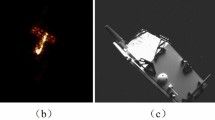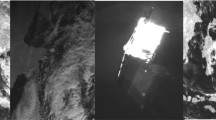Abstract
This paper introduces a new cross-domain dataset, CubeSat-CDT, that includes 21 trajectories of a real CubeSat acquired in a laboratory setup, combined with 65 trajectories generated using two rendering engines – i.e. Unity and Blender. The three data sources incorporate the same 1U CubeSat and share the same camera intrinsic parameters. In addition, we conduct experiments to show the characteristics of the dataset using a novel and efficient spacecraft trajectory estimation method, that leverages the information provided from the three data domains. Given a video input of a target spacecraft, the proposed end-to-end approach relies on a Temporal Convolutional Network that enforces the inter-frame coherence of the estimated 6-Degree-of-Freedom spacecraft poses. The pipeline is decomposed into two stages; first, spatial features are extracted from each frame in parallel; second, these features are lifted to the space of camera poses while preserving temporal information. Our results highlight the importance of addressing the domain gap problem to propose reliable solutions for close-range autonomous relative navigation between spacecrafts. Since the nature of the data used during training impacts directly the performance of the final solution, the CubeSat-CDT dataset is provided to advance research into this direction.
This work was funded by the Luxembourg National Research Fund (FNR), under the project reference BRIDGES2020/IS/14755859/MEET-A/Aouada, and by LMO (https://www.lmo.space).
Access this chapter
Tax calculation will be finalised at checkout
Purchases are for personal use only
Similar content being viewed by others
References
Blender 3.0 reference manual - blender manual. https://docs.blender.org/manual/en/latest/index.html
Bai, S., Kolter, J.Z., Koltun, V.: An empirical evaluation of generic convolutional and recurrent networks for sequence modeling. arXiv:1803.01271 (2018)
Biesbroek, R., Aziz, S., Wolahan, A., Cipolla, S., Richard-Noca, M., Piguet, L.: The clearspace-1 mission: ESA and clearspace team up to remove debris. In: Proceedings of 8th European Conference on Space Debris, pp. 1–3 (2021)
Black, K., Shankar, S., Fonseka, D., Deutsch, J., Dhir, A., Akella, M.R.: Real-time, flight-ready, non-cooperative spacecraft pose estimation using monocular imagery. arXiv preprint arXiv:2101.09553 (2021)
Corona, E., Kundu, K., Fidler, S.: Pose estimation for objects with rotational symmetry. In: IEEE International Conference on Intelligent Robots and Systems, pp. 7215–7222, December 2018. https://doi.org/10.1109/IROS.2018.8594282
D’Amico, S., Bodin, P., Delpech, M., Noteborn, R.: Prisma. In: D’Errico, M. (eds) Distributed Space Missions for Earth System Monitoring. Space Technology Library, vol. 31, pp. pp. 599–637. Springer, New York, NY (2013). https://doi.org/10.1007/978-1-4614-4541-8_21
Dung, H.A., Chen, B., Chin, T.J.: A spacecraft dataset for detection, segmentation and parts recognition. In: Proceedings of the IEEE/CVF Conference on Computer Vision and Pattern Recognition (CVPR) Workshops, pp. 2012–2019, June 2021
Garcia, A., Musallam, M.A., Gaudilliere, V., Ghorbel, E., Al Ismaeil, K., Perez, M., Aouada, D.: LSPNet: a 2d localization-oriented spacecraft pose estimation neural network. In: Proceedings of the IEEE/CVF Conference on Computer Vision and Pattern Recognition (CVPR) Workshops, pp. 2048–2056, June 2021
GSFC: NASA’s Exploration & In-space Service. NASA. https://nexis.gsfc.nasa.gov/
Haas, J.K.: A history of the unity game engine (2014)
Holschneider, M., Kronland-Martinet, R., Morlet, J., Tchamitchian, P.: A real-time algorithm for signal analysis with the help of the wavelet transform. In: Combes, J.M., Grossmann, A., Tchamitchian, P. (eds) Wavelets. IPTI, pp. 286–297. Springer, Heidelberg (1990). https://doi.org/10.1007/978-3-642-97177-8_28
Hu, J., Ling, H., Parashar, P., Naik, A., Christensen, H.I.: Pose estimation of specular and symmetrical objects. CoRR abs/2011.00372 (2020)
Hu, Y., Speierer, S., Jakob, W., Fua, P., Salzmann, M.: Wide-depth-range 6d object pose estimation in space. In: Proceedings of the IEEE/CVF Conference on Computer Vision and Pattern Recognition, pp. 15870–15879 (2021)
Kendall, A., Grimes, M., Cipolla, R.: Posenet: a convolutional network for real-time 6-DOF camera relocalization. In: Proceedings of the IEEE International Conference on Computer Vision, pp. 2938–2946 (2015)
Kisantal, M., Sharma, S., Park, T.H., Izzo, D., Märtens, M., D’Amico, S.: Satellite pose estimation challenge: dataset, competition design, and results. IEEE Trans. Aerosp. Electron. Syst. 56(5), 4083–4098 (2020)
Lepetit, V., Fua, P.: Monocular model-based 3d tracking of rigid objects: a survey. Found. Trends Comput. Graph. Vis. 1(1), 1–89 (2005)
Marchand, E., Chaumette, F., Chabot, T., Kanani, K., Pollini, A.: Removedebris vision-based navigation preliminary results. In: IAC 2019–70th International Astronautical Congress, pp. 1–10 (2019)
Mishra, N., Rohaninejad, M., Chen, X., Abbeel, P.: A simple neural attentive meta-learner (2017)
Musallam, M.A., del Castillo, M.O., Al Ismaeil, K., Perez, M.D., Aouada, D.: Leveraging temporal information for 3d trajectory estimation of space objects. In: Proceedings of the IEEE/CVF International Conference on Computer Vision (ICCV) Workshops, pp. 3816–3822, October 2021
Musallam, M.A., et al.: Spacecraft recognition leveraging knowledge of space environment: simulator, dataset, competition design and analysis. In: 2021 IEEE International Conference on Image Processing Challenges (ICIPC), pp. 11–15. IEEE (2021)
Park, T.H., Märtens, M., Lecuyer, G., Izzo, D., D’Amico, S.: Speed+: next generation dataset for spacecraft pose estimation across domain gap. arXiv preprint arXiv:2110.03101 (2021)
Park, T.H., Sharma, S., D’Amico, S.: Towards robust learning-based pose estimation of noncooperative spacecraft. arXiv preprint arXiv:1909.00392 (2019)
Pauly, L., et al.: Lessons from a space lab - an image acquisition perspective (2022). https://doi.org/10.48550/ARXIV.2208.08865, arxiv.org:2208.08865
Pellacani, A., Graziano, M., Fittock, M., Gil, J., Carnelli, I.: Hera vision based GNC and autonomy. In: 8th European Conference For Aeronautics and SP (2019). https://doi.org/10.13009/EUCASS2019-39
Pitteri, G., Ramamonjisoa, M., Ilic, S., Lepetit, V.: On object symmetries and 6d pose estimation from images. In: 2019 International Conference on 3D Vision, 3DV 2019, Québec City, QC, Canada, 16–19 September 2019. pp. 614–622. IEEE (2019)
Proença, P.F., Gao, Y.: Deep learning for spacecraft pose estimation from photorealistic rendering. In: 2020 IEEE International Conference on Robotics and Automation (ICRA), pp. 6007–6013. IEEE (2020)
Robots, U.: Ur10. https://www.universal-robots.com/products/ur10-robot/. Accessed on 11 March 2022
Taketomi, T., Uchiyama, H., Ikeda, S.: Visual SLAM algorithms: a survey from 2010 to 2016. IPSJ Trans. Comput. Vision App. 9(1), 1–11 (2017). https://doi.org/10.1186/s41074-017-0027-2
Tan, M., Le, Q.V.: Efficientnet: Rethinking model scaling for convolutional neural networks. In: Chaudhuri, K., Salakhutdinov, R. (eds.) Proceedings of the 36th International Conference on Machine Learning, ICML 2019, 9–15 June 2019, Long Beach, California, USA. Proceedings of Machine Learning Research, vol. 97, pp. 6105–6114. PMLR (2019)
University, S.: Space rendezvous laboratory. https://damicos.people.stanford.edu/. Accessed 11 March 2022
Author information
Authors and Affiliations
Corresponding author
Editor information
Editors and Affiliations
Rights and permissions
Copyright information
© 2023 The Author(s), under exclusive license to Springer Nature Switzerland AG
About this paper
Cite this paper
Musallam, M.A., Rathinam, A., Gaudillière, V., Castillo, M.O.d., Aouada, D. (2023). CubeSat-CDT: A Cross-Domain Dataset for 6-DoF Trajectory Estimation of a Symmetric Spacecraft. In: Karlinsky, L., Michaeli, T., Nishino, K. (eds) Computer Vision – ECCV 2022 Workshops. ECCV 2022. Lecture Notes in Computer Science, vol 13801. Springer, Cham. https://doi.org/10.1007/978-3-031-25056-9_8
Download citation
DOI: https://doi.org/10.1007/978-3-031-25056-9_8
Published:
Publisher Name: Springer, Cham
Print ISBN: 978-3-031-25055-2
Online ISBN: 978-3-031-25056-9
eBook Packages: Computer ScienceComputer Science (R0)




